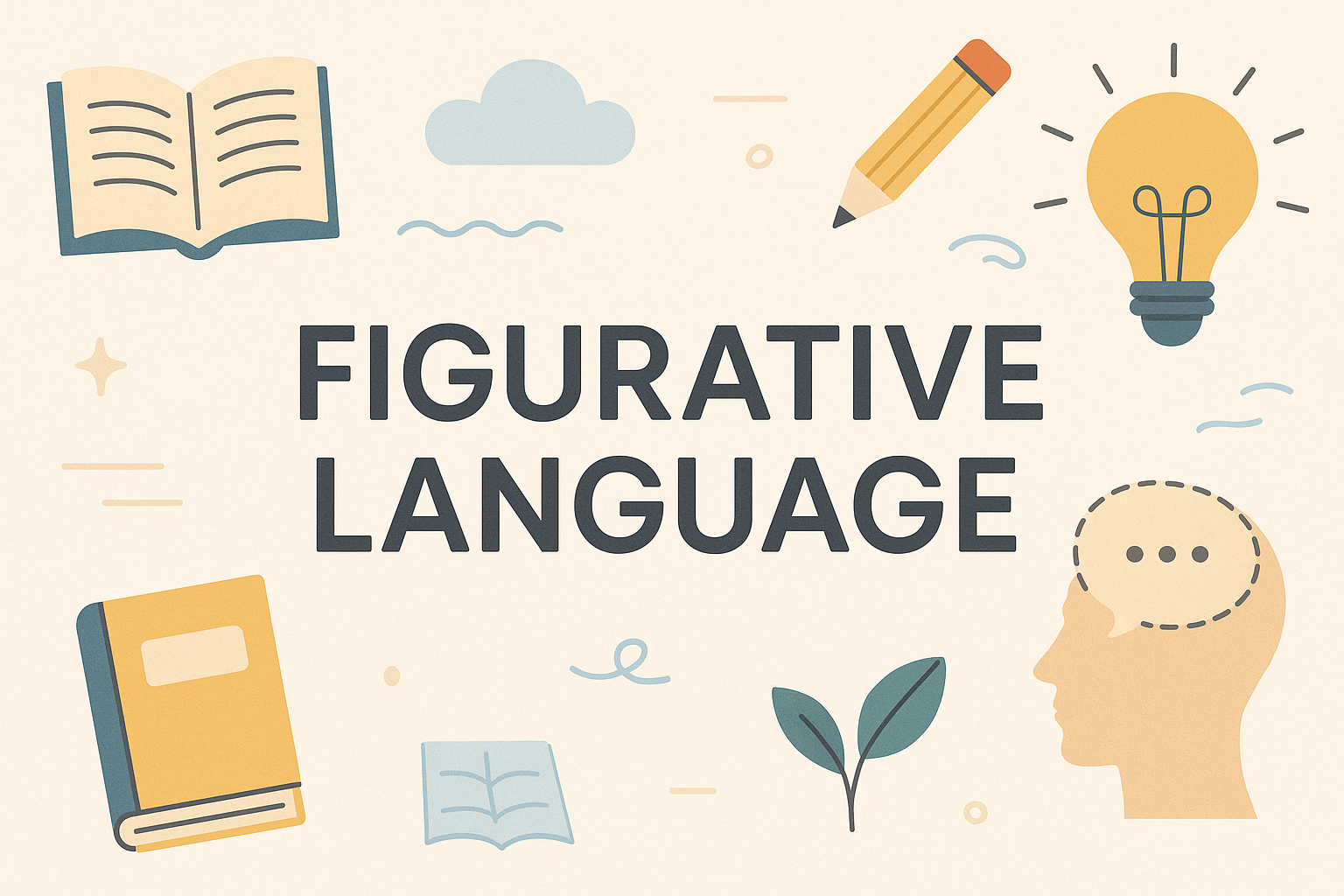Figurative language makes words pop off the page. It adds flavor to bland writing and helps people picture what’s being said. Ever heard someone say they’re “on cloud nine” or that their “hands were ice”? That’s figurative language at work. It’s not meant to be taken literally—it’s used to paint a picture, spark emotion, or make things more relatable. In this article, you’ll get figurative language examples that actually make sense, so you can stop guessing what they mean and start using them like a pro.
What is Figurative Language?
Figurative language is a way of using words that goes beyond their everyday meaning. It’s like putting your sentences in costume—making them more dramatic, colorful, or poetic. Writers use it to create strong mental pictures, exaggerate feelings, or compare two things that aren’t alike. This helps the reader feel something, see something, or think about something in a new way. You’ll spot it in poems, songs, novels, and even everyday conversation. It’s what turns plain writing into something more expressive and memorable.
Why Writers Use Figurative Language
Think of figurative language like seasoning in food. Without it, your message might still be clear, but it won’t grab anyone’s attention. It adds flavor, depth, and a sense of personality to your words. It helps sentences stand out and gives writing a rhythm that keeps people reading. Figurative language adds more than flair—it shapes how ideas are felt and remembered. Writers use it to:
Make abstract ideas easier to understand
Bring emotion into writing
Help readers visualize scenes or feelings
Add humor or drama
Keep things interesting
It’s like telling someone “he’s a walking encyclopedia” instead of “he knows a lot.” One paints a stronger picture and leaves a lasting impression.

Types of Figurative Language
Figurative language comes in many forms, each with its own way of adding meaning, humor, emotion, or emphasis. Let’s look at eight common types that writers and speakers use every day. These figurative language examples help turn ordinary phrases into something more expressive and memorable. When used well, they can help the reader connect with ideas, feel what the writer feels, or laugh at a clever turn of phrase. You’ll find them in poems, speeches, fiction, and even casual conversation. They don’t just decorate writing—they guide the tone, rhythm, and mood. Some forms are more playful, while others push emotions to the surface or add clarity to complex ideas. These types are building blocks for storytelling and communication.
Here are the 8 types we’ll cover:
Simile
Metaphor
Personification
Hyperbole
Idiom
Alliteration
Onomatopoeia
Oxymoron and Paradox
Each one brings something unique to the table and gives language the power to leave a lasting impression on the reader.
Simile
A simile compares two different things using the words “like” or “as.” It’s one of the most popular forms of figurative language because it’s easy to understand and helps create strong comparisons that spark the imagination. Instead of just saying someone is fast, you might say “He ran like the wind.” That paints a clearer picture and gives the reader a feeling of speed and intensity. Similes help writers show, not just tell, which makes their descriptions more interesting to read. They also add a personal tone—people relate better to everyday comparisons than plain facts. Similes can be used seriously or with a bit of humor, depending on the tone you’re aiming for.
Examples:
She was as graceful as a swan.
His temper flared like a volcano.
That baby is as cute as a button.
The night was as black as coal.
He fought like a lion in battle.
Metaphor
A metaphor goes a step further than a simile by saying one thing is another. It doesn’t use “like” or “as”—instead, it draws a direct connection between two things to create a stronger effect. Metaphors make abstract or complex ideas easier to grasp. If someone says, “Time is a thief,” they don’t mean time has hands and steals from you. They mean it takes things away silently—like your youth, your opportunities, or your energy. Metaphors help writing feel deeper and more emotional. They’re especially common in poetry, literature, and motivational speeches. Used well, they can change how people think or feel about a subject instantly.
Examples:
Time is a thief.
Her eyes were oceans of emotion.
The classroom was a war zone during finals.
Life is a rollercoaster.
His words were daggers in her heart.

Personification
Personification gives human qualities to objects, animals, or abstract ideas. It lets you treat non-human things as if they had feelings, thoughts, or intentions. This helps readers connect with things on an emotional level and makes writing more engaging. For example, saying “The wind whispered through the trees” gives the wind a soft, mysterious personality. It adds atmosphere and mood. This technique is often used in poetry and fiction, but you’ll also hear it in everyday speech. It’s a playful and powerful way to add character to your scenes and surroundings, making even a rock feel alive in a story.
Examples:
The wind whistled through the trees.
My alarm clock screamed at me this morning.
The flowers danced in the breeze.
The car groaned as it climbed the hill.
The moon smiled down on the valley.
Hyperbole
Hyperbole is all about exaggeration. It takes something ordinary and blows it out of proportion to make a point, usually for humor or drama. People use hyperbole all the time in everyday speech: “I’m so hungry I could eat a horse,” or “This bag weighs a ton.” Nobody means these things literally—they’re used to express intensity. In writing, hyperbole can add excitement, stress a feeling, or make a character sound emotional or dramatic. It’s great for catching a reader’s attention or showing how big, bad, exciting, or awful something feels without needing long descriptions.
Examples:
I’ve told you a thousand times.
My backpack weighs a ton.
She ran faster than lightning.
He was dying of boredom.
That joke was so old it came with a dinosaur.
Idiom
An idiom is a phrase where the meaning isn’t clear from the words themselves. You have to understand the cultural context. Idioms often confuse people learning a new language because they don’t follow logical rules. Still, they’re everywhere—in conversations, books, and even business emails. Idioms give language personality. Instead of saying “You should give up,” someone might say, “Throw in the towel.” It’s a more colorful way to communicate. Many idioms come from sports, history, or old traditions and get passed down over time.
Examples:
Spill the beans – reveal a secret
Hit the nail on the head – get something exactly right
Bite the bullet – do something unpleasant you’ve been avoiding
Let the cat out of the bag – accidentally share information
Under the weather – feeling sick
Alliteration
Alliteration is the repetition of the same starting sound in a string of words. It’s used a lot in poetry, songs, business names, and tongue twisters. It creates a musical effect that can make phrases more memorable. You’ve probably heard phrases like “Busy as a bee” or “Whispering winds.” These sound patterns catch the reader’s ear and often create a soothing, rhythmic quality. Alliteration can also set the mood—soft sounds feel gentle, while sharp ones can feel urgent or aggressive. It’s often used in branding because it helps names stick, like “Coca-Cola” or “PayPal.”
Examples:
Peter Piper picked a peck of pickled peppers.
Sally sells seashells by the seashore.
Busy bees buzzed by briskly.
Wild winds whipped wildly.
Larry’s lizard likes leaping leopards.
Onomatopoeia
Onomatopoeia refers to words that imitate sounds. It helps bring scenes to life by letting the reader hear what’s happening through the page. In comic books, you’ll see words like “BAM!” or “CRASH!” These mimic real-life noises and add intensity. Writers use onomatopoeia to make a scene more sensory and active. It’s popular in children’s books, action scenes, and poems because it makes things more entertaining and visual. These words often stand alone in a sentence to mimic sound effects directly.
Examples:
The door creaked open.
The balloon popped.
The bacon sizzled in the pan.
The bees buzzed angrily.
The thunder rumbled across the sky.
Oxymoron and Paradox
Oxymoron and paradox both involve contradictions, but they function differently. An oxymoron is a short phrase that places two opposite words together. These often create a striking or funny effect, like “jumbo shrimp” or “seriously funny.” They work because our minds notice the conflict. A paradox, on the other hand, is a full statement that seems confusing at first but actually holds truth. It often challenges people to think differently and can reveal something deep about life or ideas. Both are used to provoke thought and add clever twists to writing.
Oxymoron Examples:
Bittersweet memory
Clearly confused
Deafening silence
Act naturally
Living dead
Paradox Examples:
This is the beginning of the end.
Less is more.
The only constant is change.
You must be cruel to be kind.
The silence was loud.
| Type | Short Example |
|---|---|
| 📏 Simile | "He ran like the wind." |
| 🔗 Metaphor | "She was a rock during the crisis." |
| 🌟 Personification | "The stars danced in the sky." |
| 🔥 Hyperbole | "I'm starving to death." |
| 🧩 Idiom | "Let’s call it a day." |
| 🌀 Alliteration | "Big brown bears bounced bravely." |
| 🔊 Onomatopoeia | "Splash, bang, boom." |
| 🧠 Oxymoron/Paradox | "Act naturally" or "The silence was loud." |
Want to Spot Figurative Language? Ask These Questions
Next time you see a phrase that sounds a little too creative to be literal, ask yourself:
Is this comparing two things?
Is this exaggerating?
Can this object really do that?
Does it sound like a real noise?
If you answer “yes” to any of those, chances are you’re looking at one of many figurative language examples. Figuring it out gets easier the more you read or write. Some figurative phrases are obvious—like “I’m drowning in paperwork”—while others are more subtle, such as “time slipped away.” Both pull you away from literal meaning and into imagination or emotion.
To get better at spotting figurative language, try keeping a small journal. Anytime you read or hear a fun or strange expression, write it down and label what type it is. You’ll be surprised how often people use them without even realizing it. The more you notice these phrases, the more natural they’ll feel in your own writing. Give it a shot—try crafting a short paragraph using three different types and see how your ideas come to life.




